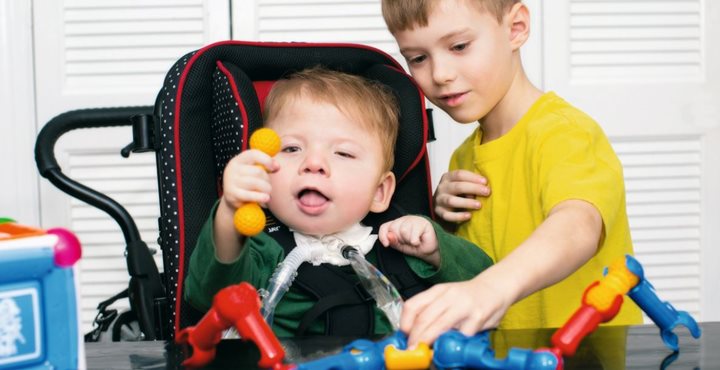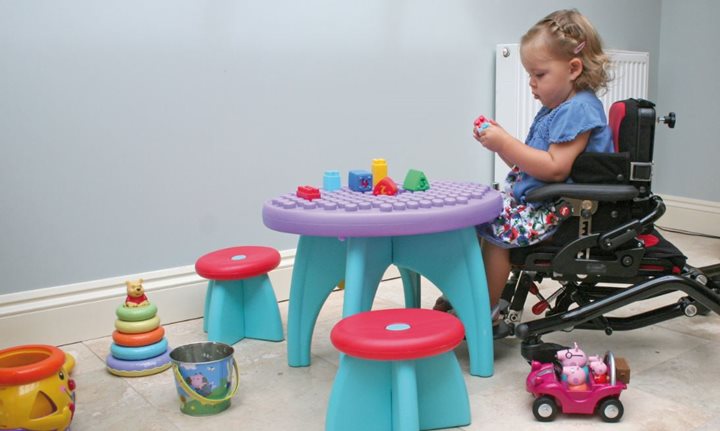Share:
Take it offline!
This Education in Motion resource is also available as a printable PDF.
Download PDF
Children naturally love to play. It’s necessary for learning and development and is even a right for them, as enacted the General Assembly of the United Nations in 1959. Whilst, playing may come naturally to a child it is an adult’s responsibility to provide children with adequate opportunities for play.
The adaptation and creation of games for children with disabilities is fundamental for the development and stimulation of children with accessibility problems, not forgetting that the universal design in games and toys benefits the whole of society, as it allows everyone, with or without disability, to share resources and moments of enjoyment.

Games, toys and disability: integration, stimulation and development
Childhood games are synonymous with activity, development and preparation for adult life. They are a source of self-affirmation, motivation, satisfaction and social interaction. In the case of children with some sort of disability, all these benefits are multiplied, so that the game becomes an occupational area essential for their social, cognitive, sensory, prescriptive, affective and communicative development.
And all this without forgetting that games for the disabled are also fundamental tools to achieve educational objectives. However, children with disabilities often encounter difficulties in the game if the marketed toys are not adapted to their needs, or when playing group games.
On the other hand, and because of the great diversity of disabilities (motor, cognitive, sensory, perceptive, relational), it is difficult to establish global guidelines to define games for the disabled that are advisable for each age group and, ultimately, professionals (doctors and specialists) and family members are the ones who detect the characteristics and needs of each child.

Games for children with disabilities: advice on choosing them
Age and type of disability are key when choosing toys and games. In cases of motor disability, for example, accessibility in toys for babies is quite high because at an early age the mobility of babies with or without disabilities is similar, but this decreases as the age at which toys are targeted increases.
Note also that with some disabilities children have different learning rhythms, so it is important to question the indications regarding age according to specific cases.
Even so, when talking about games for children with disabilities, we can establish the following general guidelines.
- Look for toys with different visual designs, use and play (characteristics of toys with universal design)
- Choose toys that allow you to change the rules so you can easily adapt them.
- Promote exploration and participation of children so that they realise what they can do, and also what they like most.
- Don’t forget that stimulation through games for those with disabilities is both an individual and group experience. The former reinforces personal autonomy while the latter promotes communication and teamwork.
- When carrying out group activities with children with and without disabilities, use the same toys so that no one feels excluded.
- If a child shows difficulty handling a toy, help him or her place themselves properly or give them the resources they need to improve their play.
- Messy play (using sand, water, finger paints, play dough, kneading, wax, plasticine...) favours sensory and motor development.
- When proposing games, always try to combine tradition and innovation. Traditional games (games with songs, etc.) favour the sensorimotor development of children and encourage social relations; technologically advanced toys use very interesting and useful programmes and adaptations for children with disabilities.

Games for children with motor disabilities: difficulties and basic adaptations
Normally, children with motor disabilities begin their physical rehabilitation in the first months of life and their parents put a lot of energy and enthusiasm into this activity, where enjoyment should be introduced as a fundamental element through play.
Among the main difficulties that children with motor disabilities find when playing a game, is handling problems with movement, the mobility of body parts, reaching the pieces, and the accuracy of movement and coordination.

One of the keys to adapting games for the disabled is through the use of push buttons. These, besides being an action which stimulates the game, are used in other devices such as computers, controls, switches or keys, which are crucial everyday elements, and whose control means greater autonomy for the disabled.
Other key elements to choosing adapted and stimulating toys for children with motor disabilities are:
- That children can manipulate them without help from third parties to reinforce their autonomy.
- That buttons are accessible, identifiable and easy to operate.
- That the size of large furniture-like structures (kitchens, workbenches, etc.) allow entry of a wheelchair or the breakdown by pieces for separate use.
- That table-top toys have anti-slip surfaces on the bottom.
- That simultaneous movements are avoided (for example, pressing two things at the same time)
At Sunrise Medical, we encourage the young ones on their quest for adventure through the ZIPPIE range of children's wheelchairs. Discover these robust, compact and easy to handle chairs that will follow their growth thanks to its adjustable design.